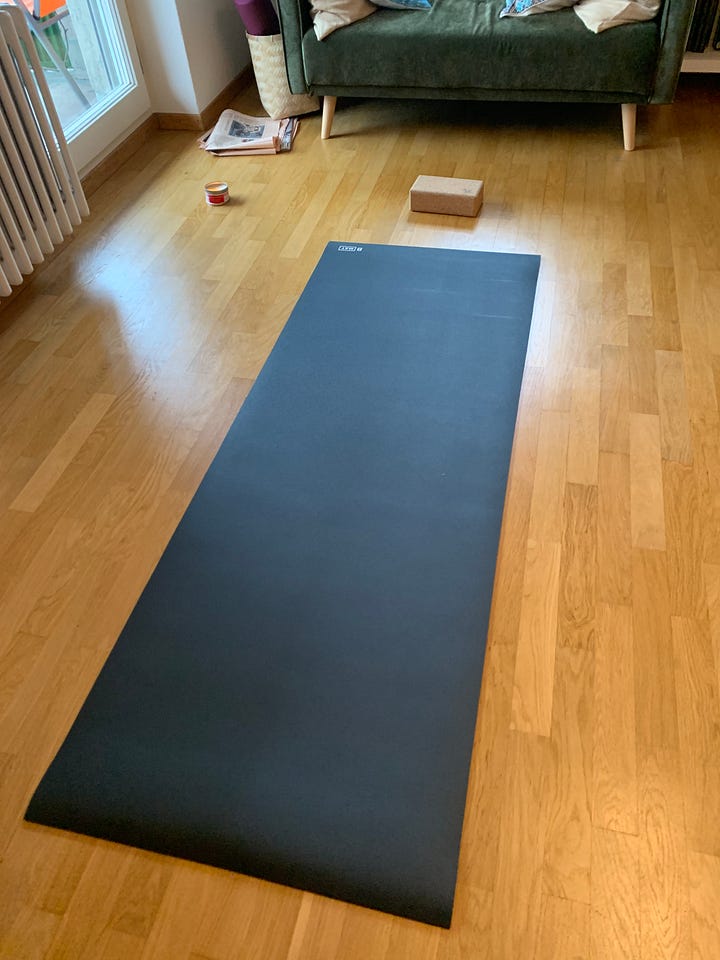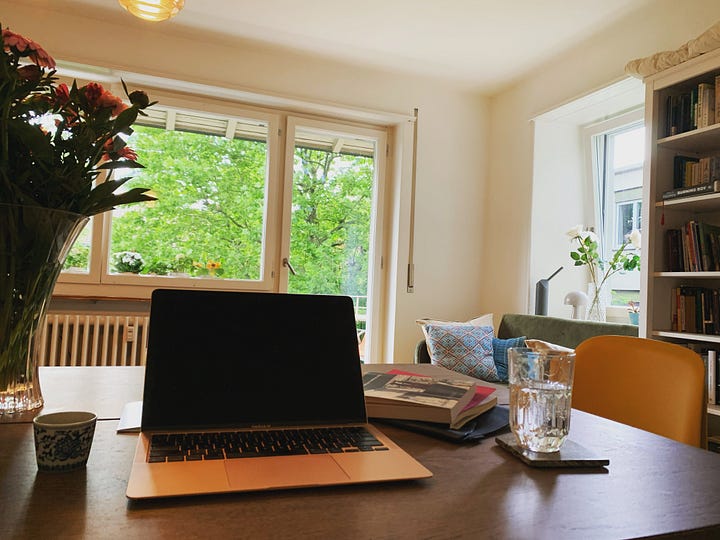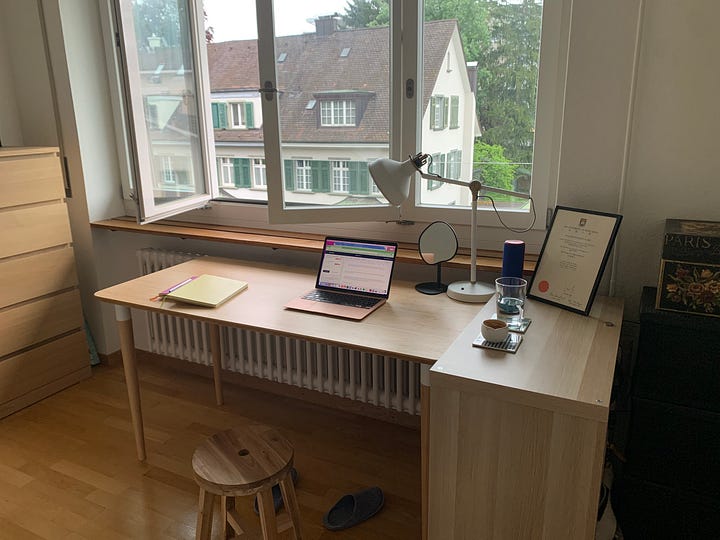Welcome back to Yoga Culture’s Yoga & Writing, everyone.
We talk about intentions in yoga classes. It’s something to help us focus or to channel our energy. We also do this as we write: what’s the intention of this story or letter? Or for ourselves: the intention of the writing session itself (i.e. to clear the mind, to produce xyz, share opinion).
But what about the space in which we practice? We can’t all have a window at home that looks out on a lake like the photo above. However, we can still make our spaces intentional by other factors that don’t necessarily cost any money.
I’m sort of obsessed with the way space creates meaning and the way we feel in different spaces. Today’s post is moving into experimental ideas. I would love to hear your thoughts on the topic. Maybe one of you is a Feng Shui master! Let us know in the comments or just let us know what kind of spaces you practice in.
Also: I’ll be sharing a podcast version of this post next Thursday on the podcast that accompanies my other Substack. You can follow on Apple, Spotify, Podbean, and other listening apps to get a notification about it.
Thanks for being here!
Intentional Spaces
We move through the spaces of our lives like the negative spaces of a giant sculpture. Carving our existence into the world as we enter the void, we interact with textures and surfaces, walls and windows, pathways and placed objects. We navigate. We inhabit. We create within and between and atop.

Shells
Let us start in the home. We create within our shells, and then we emerge. It is human to retreat in order to form the self as whole.
I want to call upon the work of Gaston Bachelard in The Poetics of Space (France, 1958) to think about this concept. He uses this shell, which he devotes an entire chapter to, as metaphor for our identities, giving us power to independently filter and select what’s out there in order to be authentic and evolve in ways that we choose.
…by staying motionless in its shell, the creature is preparing temporal explosions, not to say whirlwinds, of being.
Bachelard, p. 111
I think of Savasana. Seated meditation. Motionless observation or internal composition as a writer.
In the previous chapter, Bachelard talks about “nests” as the places of refuge. He proclaims that “with nests and, above all, shells, we shall find a whole series of images that…bring out primitiveness in us” and discusses the pleasure humans have in “withdraw[ing] into [a] corner” (p. 91).
Victor Hugo likens Notre Dame Cathedral to “‘egg, nest, house, country and universe’” (p. 90). Quasimodo finds joy and individual meaning in all the tiny spaces of the cathedral just as he does in the space as an entire symbol.
Bachelard continues by talking about the nest as a place of building confidence, finding natural rhythms, and daydreaming to create understandings. It is a safe and natural abode that we can return to whenever needed.
A beautiful passage discusses Henry David Thoreau’s Journals (1858) that describe a nest as metaphor for human homes (p. 96):
Thoreau tells of a green woodpecker that took an entire tree for its home. He compares this taking possession with the joy of a family that returns to live in a house it had long since abandoned.
“It is as when a family, your neighbors, return to an empty house after a long absence, and you can hear the cheerful hum of voices and the laughter of children, and see the smoke from the kitchen fire.”
We may have many ‘homes’…where we were raised, where we live, maybe even yoga studios or friendly cafes. If we feel we are in refuge when we are in the space, then it is a home. And it can likewise be a home to our independent thoughts and self-formations.
Bachelard even suggests the entire world can be a nest: “an immense power holds the inhabitants of the world in its nest” (p. 104").
Home spaces
So what does it take for a space to feel like home? That is, nurturing, comfortable, free, perhaps fun?
Do you have tiny corners in which you practice or a large barn for the purpose?
What do we put in these spaces? What do we see from these spaces?
Sometimes we don’t get a lot of choice in selecting the space or furniture in which we practice, but there still might be ways of manipulating the space, like a nest, to make it your shell of discovery.
I live in an apartment with my family and the living/dining area turns into my personal yoga studio and writing office during the day. In this room are bookshelves, a large wooden table with wooden bench, a small green couch, and a few paintings, photographs, and flower vases (sometimes filled). It also has a glass door out to the small balcony.
I keep my yoga necessities in a basket next to the couch for early morning sessions and just for ease when the opportunity or calling arises during the day. There, I set my mat facing the glass door to look out at the trees and birds or occasional squirrels. Or occasionally, I practice on the wooden floor to feel the coldness and the little parts of my palms and feet that normally are swallowed by the mat. The best time of year is winter when I start in complete darkness and move toward the glow of sunrise.
The other side of the flat faces a road and palliative care center. It’s a completely different view and the noise of early morning deliveries carries straight into our bedroom. The other side - my shell-space - feels like a refuge from this. The wake up here is more natural.
But in the bedroom, I also have my desk, housing notebooks and calendars, pens, computer, charger, and things like this. Often I organize myself there a bit later in the morning. I feel a little more a part of the world as I hear people walking on the sidewalk below.
It also serves well to take just what I need onto the long wooden table for writing sessions. Often following the early morning yoga, my journal or computer are already waiting there, ready for a short dive into my mind. Later, they may also be surrounded by books and lists, a phone timer, coffee, and bowls of nuts.
I position myself toward that same window view. You’d think I would be sick of it by now. Sure, the trees change by season, but it's otherwise the same every day. I change the flowers occasionally and superfluous things in the room (though I try to keep it fairly empty). But I always sit in the same spot more or less. I open the door for outdoor air unless it is way too cold or hot. I work within the sounds of nature (mixed with an occasional jackhammer or truck that whips around the building to find me there).
What do you choose to allow in your space? Do you consider the sensory experience?
The smell of the space also changes when I open the windows. In the winter I might use a candle as well. Incense is nice for yoga but my husband can’t stand it, so I kindly only use it if I can keep the windows open several hours after. Or can you smell your bread machine working? Perfumes? Cleaning products?
We can control many parts of our home environment, which is why it often appeals as an intentional space. We create something in which we may cocoon ourselves. We put value on the small parts that make it feel comfortable.
But, I would argue, it is also the smallness of intimate spaces that makes something unusual in the home, or its corners. Colum McCann writes in a converted closet: “‘It concentrates my vision. No windows, two very tight walls.’” Roald Dahl wrote in a sleeping bag within a garden shed.
And here’s a practical article by Melanie Marttila on Why Every Writer Needs a Room of Their Own (Even if It’s Not a Room). She’s alluding to Virginia Woolf’s famous essay and lecture. We must, of course, include a part of Woolf’s essay to consider in our intentional spaces as writers, and I think you will find that she has a yogi way of considering reality and the self:
But when I look back through these notes and criticise my own train of thought as I made them, I find that my motives were not altogether selfish. There runs through these comments and discursions the conviction--or is it the instinct?--that good books are desirable and that good writers, even if they show every variety of human depravity, are still good human beings. Thus when I ask you to write more books I am urging you to do what will be for your good and for the good of the world at large. How to justify this instinct or belief I do not know, for philosophic words, if one has not been educated at a university, are apt to play one false. What is meant by "reality"? It would seem to be something very erratic, very undependable--now to be found in a dusty road, now in a scrap of newspaper in the street, now a daffodil in the sun. It lights up a group in a room and stamps some casual saying. It overwhelms one walking home beneath the stars and makes the silent world more real than the world of speech--and then there it is again in an omnibus in the uproar of Piccadilly. Sometimes, too, it seems to dwell in shapes too far away for us to discern what their nature is. But whatever it touches, it fixes and makes permanent. That is what remains over when the skin of the day has been cast into the hedge; that is what is left of past time and of our loves and hates. Now the writer, as I think, has the chance to live more than other people in the presence of this reality. It is his business to find it and collect it and communicate it to the rest of us. So at least I infer from reading Lear or Emma or La Recherche du Temps Perdu. For the reading of these books seems to perform a curious couching operation on the senses; one sees more intensely afterwards; the world seems bared of its covering and given an intenser life. Those are the enviable people who live at enmity with unreality; and those are the pitiable who are knocked on the head by the thing done without knowing or caring. So that when I ask you to earn money and have a room of your own, I am asking you to live in the presence of reality, an invigorating life, it would appear, whether one can impart it or not.
Earlier in the essay, Woolf reminds us as she is a woman locked out of an institution’s library (only for men admitted to the university) that it is indeed better to be locked out than locked in. Her thoughts stray from the path and her ‘room’ is one of her own making.
Out
So we can therefore find these ‘rooms’ and ‘shells’ outdoors as well - in libraries or cafes, on park benches or in borrowed spaces. Some cannot practice at home. Too many distractions; not enough space. Or some like to shift the experience depending on one’s mood or project. Some people fall into patterns of feeling safer in their own controlled environment and fear the unknown of communal spaces. This is especially true after the pandemic.
There are many joys in the intentional spaces of community, created by someone else for you to experience something. Yoga studios, yoga in the park, cafes, bars, libraries…
Somebody else sets up the tables or the mats. Cleans it for you. Selects music. Offers nourishment. You trust them to create an experience for you and part of the joy is in not knowing exactly what will be there. Juxtapositions are made by many factors of chance mixed with purposeful choice, establishing an experience unique to you and completely unexpected.
What makes you feel at home in a yoga studio? Is it the teacher? The windows? The smell? The music?
And a cafe? For me, the table and chairs make a big difference. The quality of the (smell of) coffee is also a perk. But the biggest factor is where my eyes will be looking when not on my computer or notebook.
**Later, I will do a follow-up about intentional classroom spaces, whether yoga studios or writing classrooms. How do we ask students to inhabit the space? How do we create a space of trust and respect, so that it can also provide us with these independent thinking and rewarding experiences, but as a collective?**
Imperfect spaces




Creating an intentional space doesn’t mean a perfect space. In yoga, we acknowledge our limitations. Money and location, especially, might determine what kind of space you practice yoga in and you write.
In yoga and in writing, we often think about coming inward, discarding distractions such as noise, life’s difficulties, or the news. However, meditation teaches us to also sit with these problems. Whether you’re actually sitting or not doesn’t matter, but the way you consider yourself in the space of your practice and beyond does.
While we may want these distractions to move away from the front of our mind, we need to let them be there. They are a part of us and the universe, which is in turn a part of us, too. Rather than denying, we can be alongside. The idea that our existence might be important or integral to the greater working of the world is a powerful one. Imagine yourself giving off a kind of energy as you practice. That energy is carried with you through your day, given off subtly to others in the way you interact with them, whether in person or online. In turn, that impacts their energy. It creates a butterfly effect that can create change.
What I mean is, you might think you’re writing in a vacuum. I have friends who have written ten full screenplays in one case and three novels in another without sharing them with a single person. The first reaction might be: what’s the point? And while I think sharing your writing with others has a lot of benefits, let’s just leave that out of this discourse for now and consider that this person, as they write, has joy or is able to work through some inner conflict or see something beautiful in the world. That’s a good reason to write in itself, but then this person also brings that joy or balance or awareness of beauty to others. To friends, partners, the barista, their kid’s teacher…you get the idea. The writing is implicitly communicating with many people, even when it remains unseen.
The same is true with yoga. You might practice at a studio or in a park with others and perhaps share a chat before or after and hear a story or physiological idea from your instructor together (or create one for your students in the case of yoga teachers). But when you practice alone, it’s not really solitary. The way you feel after a practice travels with you or flows through the words your write.
“Poetic space, because it is expressed, assumes values of expansion” (Bachelard, p. 201)
There is no limit on poetic space, which is also interior or intimate space: your mind’s imagination and ability to see the world in new ways.
Tapas in yoga refers to the presence and motivation in our daily practice, an austerity of being and forging our true character. What does the intentional space achieve? It’s a kind of creativity in itself a sort of joy and satisfaction with the world you can create. It might just end up creating…yourself.
I leave you with a couple of filmic writing spaces and would love to hear about your own intentional spaces in the comments. Thanks for reading!







The idea of a space to write and to practice yoga is something that always interests me. I crave the idea of the "perfect" spot to do both, though then I put too much pressure on myself! One thing the pandemic threw up for me though was that I no longer have a solid home yoga practice. I think that because studios and gyms were closed for so long, and I had to attend at home Zoom classes, as soon as in person ones reopened I have never been able to get my home practice going again!
I always look forward to your posts! My yoga and writing spaces are in the same room--a big L-shaped room that we had intended to be our bedroom but which didn’t quite fit our bed so it became my office (the long part of the L) and a nook for my yoga practice (the short part of the L) alongside a closet meant for clothes that is perfect for my yoga props. It’s such a treat to always be so close to my mat, but I also have to be sure to close up my workspace for the day so I can be present and not think “oh, I should send that email real quick” when I’m practicing. Still, it’s a lovely set up and I’m grateful for it!